Tunable Fluorescence via Self-Assembled Switching of AIE-Active Micelle-like Nanoaggregates
Abstract
1. Introduction
2. Results
2.1. Design and Optical Properties of 1,8-Naphthalic Anhydride Derivatives
2.2. Self-Assembly of NAXC
2.3. Aggregation-Induced Emission Enhancement
2.4. Time-Dependent Color Reversible Changes of the Fluorescent Aggregates
3. Discussion
4. Materials and Methods
4.1. Materials
4.2. Apparatus
4.3. Synthesis
5. Conclusions
Supplementary Materials
Author Contributions
Funding
Institutional Review Board Statement
Informed Consent Statement
Data Availability Statement
Conflicts of Interest
References
- Olsen, S. Locally-Excited (LE) versus Charge-Transfer (CT) Excited State Competition in a Series of Para-Substituted Neutral Green Fluorescent Protein (GFP) Chromophore Models. J. Phys. Chem. B 2015, 119, 2566–2575. [Google Scholar] [CrossRef] [PubMed]
- Sirbu, D.; Butcher, J.B.; Waddell, P.G.; Andras, P.; Benniston, A.C. Locally Excited State–Charge Transfer State Coupled Dyes as Optically Responsive Neuron Firing Probes. Eur. J. Chem. 2017, 23, 14639–14649. [Google Scholar] [CrossRef] [PubMed]
- Hong, Y.; Lam, J.W.Y.; Tang, B.Z. Aggregation-induced emission: Phenomenon, mechanism and applications. Chem. Comm. 2009, 14, 4332–4353. [Google Scholar] [CrossRef]
- Wang, Y.; Liu, H.; Chen, Z.; Pu, S. Aggregation-induced emission enhancement (AIEE)-active tetraphenylethene (TPE)-based chemosensor for CN−. SAA Mol. Biomol. Spectrosc. 2021, 245, 118928. [Google Scholar] [CrossRef]
- Fang, H.; Shi, R.; Chen, D.; Qu, Y.; Wu, Q.; Yang, X.; Lu, X.; Zhang, C.-W.; Li, L.; Lim, K.-L. Intramolecular charge transfer enhancing strategy based MAO-A specific two-photon fluorescent probes for glioma cell/tissue imaging. Chem. Comm. 2021, 57, 11260–11263. [Google Scholar] [CrossRef] [PubMed]
- Kukhta, N.A.; Bryce, M.R. Dual emission in purely organic materials for optoelectronic applications. Mater. Horiz. 2021, 8, 33–55. [Google Scholar] [CrossRef] [PubMed]
- Lippert, E.; Lüder, W.; Boos, H. Advances in Molecular Spectroscopy; Elsevier: Amsterdam, The Netherlands, 1962; pp. 443–457. [Google Scholar] [CrossRef]
- Bolduc, A.; Dong, Y.; Guérin, A.; Skene, W.G. Solvatochromic investigation of highly fluorescent 2-aminobithiophene derivatives. Phys. Chem. Chem. Phys. 2012, 14, 6946–6956. [Google Scholar] [CrossRef]
- Bu, L.; Chen, J.; Wei, X.; Li, X.; Ågren, H.; Xie, Y. An AIE and ICT based NIR florescent probe for cysteine and homocysteine. Dye. Pigm. 2017, 136, 724–731. [Google Scholar] [CrossRef]
- Druzhinin, S.I.; Galievsky, V.A.; Demeter, A.; Kovalenko, S.A.; Senyushkina, T.; Dubbaka, S.R.; Knochel, P.; Mayer, P.; Grosse, C.; Stalke, D.; et al. Two-state intramolecular charge transfer (ICT) with 3,5-dimethyl-4(dimethylamino)benzonitrile (MMD) and its meta-isomer mMMD. Ground state amino twist not essential for ICT. J. Phys. Chem A 2015, 119, 11820–11836. [Google Scholar] [CrossRef]
- Tarai, A.; Huang, M.; Das, P.; Pan, W.; Zhang, J.; Gu, Z.; Yan, W.; Qu, J.; Yang, Z. ICT and AIE Characteristics Two Cyano-Functionalized Probes and Their Photophysical Properties, DFT Calculations, Cytotoxicity, and Cell Imaging Applications. Molecules 2020, 25, 585. [Google Scholar] [CrossRef]
- Yang, W.; Li, C.; Zhang, M.; Zhou, W.; Xue, R.; Liu, H.; Li, Y. Aggregation-induced emission and intermolecular charge transfer effect in triphenylamine fluorophores containing diphenylhydrazone structures. Phys. Chem. Chem. Phys. 2016, 18, 28052–28060. [Google Scholar] [CrossRef] [PubMed]
- Ruixue, Z.; Yang, L.; Xunxue, Z.; Yuai, D.; Tianyu, H. Fabricating D-A type AIE luminogen into film sensor for turn-on detection of methanol vapour. Sens. Actuators B Chem. 2020, 319. [Google Scholar] [CrossRef]
- Chen, Y.; Fang, Y.; Gu, H.; Qiang, J.; Li, H.; Fan, J.; Cao, J.; Wang, F.; Lu, S.; Chen, X. Color-Tunable and ESIPT-Inspired Solid Fluorophores Based on Benzothiazole Derivatives: Aggregation-Induced Emission, Strong Solvatochromic Effect, and White Light Emission. ACS Appl. Mater. Interfaces 2020, 12, 55094–55106. [Google Scholar] [CrossRef] [PubMed]
- Hasrat, K.; Wang, X.; Li, Y.; Yang, L.; Zhao, Y.; Xue, K.; Wang, X.; Deng, J.; Liang, J.; Qi, Z. Organic AIE material based on D-π-A for detecting lipid droplets in living cells and its application in photodynamic therap. Dyes Pigm. 2023, 211, 111096. [Google Scholar] [CrossRef]
- Myers, D. Surfactant Science and Technology: Myers/Surfactant Science and Technology, 3rd ed.; A John Wiley & Sons Inc.: Hoboken, NJ, USA, 2005. [Google Scholar]
- Wu, W.-C.; Chen, C.-Y.; Tian, Y.; Jang, S.-H.; Hong, Y.; Liu, Y.; Hu, R.; Tang, B.Z.; Lee, Y.-T.; Chen, C.-T.; et al. Enhancement of Aggregation-Induced Emission in Dye-Encapsulating Polymeric Micelles for Bioimaging. Adv. Funct. Mater. 2010, 20, 1413–1423. [Google Scholar] [CrossRef]
- Breul, A.M.; Hager, M.D.; Schubert, U.S. Fluorescent monomers as building blocks for dye labeled polymers: Synthesis and application in energy conversion, biolabeling and sensors. Chem. Soc. Rev. 2013, 42, 5366–5407. [Google Scholar] [CrossRef]
- Chiang, Y.C.; Lai, Z.L.; Chen, C.M.; Chang, C.C.; Liu, B. Construction of emission-tunable nanoparticles based on a TICT-AIEgen: Impact of aggregation-induced emission versus twisted intramolecular charge transfer. J. Mater. Chem. B 2018, 6, 2869–2876. [Google Scholar] [CrossRef]
- Cabral, H.; Miyata, K.; Osada’, K.; Kataoka, K. Block Copolymer Micelles in Nanomedicine Applications. Chem. Rev. 2018, 118, 6844–6892. [Google Scholar] [CrossRef]
- Yang, H.; Shang, Z.; Shi, Q.; Gao, J.; Wang, X.; Hu, F. Combination of PEG-b-PAA Carrier and Efficient Cationic Photosensitizers for Photodynamic Therapy. Chem. Asian J. 2023, 18, e202300212. [Google Scholar] [CrossRef]
- Tang, S.; Yang, R.; Gao, Y.; Zhu, L.; Zheng, S.; Zan, X. Hydrazone-based amphiphilic brush polymer for fast endocytosis and ROS-active drug release. ACS Macro Lett. 2023, 12, 639–645. [Google Scholar] [CrossRef]
- Park, T.; Han, M.; Schanze, K.S.; Lee, S.H. Ultrasensitive determination of trypsin in human urine based on amplified fluorescence response. ACS Sens. 2023. [Google Scholar] [CrossRef] [PubMed]
- Lin, H.H.; Chan, Y.C.; Chen, J.W.; Chang, C.C. Aggregation-induced emission enhancement characteristics of naphthalimide derivatives and their applications in cell imaging. J. Mater. Chem. 2011, 21, 3170–3177. [Google Scholar] [CrossRef]
- Lin, H.H.; Su, S.Y.; Chang, C.C. Fluorescent organic nanoparticle formation in lysosomes for cancer cell recognition. Org. Biomol. Chem. 2009, 7, 2036–2039. [Google Scholar] [CrossRef] [PubMed]
- Su, S.Y.; Lin, H.H.; Chang, C.C. Dual optical responses of phenothiazine derivatives: Near-IR chromophore and water-soluble fluorescent organic nanoparticles. J. Mater. Chem. 2010, 20, 8653–8658. [Google Scholar] [CrossRef]
- Chen, J.W.; Chang, C.C. A Dual Anticancer Efficacy Molecule: A Selective Dark Cytotoxicity Photosensitizer. ACS Appl. Mater. Interfaces 2016, 8, 29883–29892. [Google Scholar] [CrossRef]
- Engels, B.; Engel, V. The dimer-approach to characterize opto-electronic properties of and exciton trapping and diffusion in organic semiconductor aggregates and crystals. Phys. Chem. Chem. Phys. 2017, 19, 12604–12619. [Google Scholar] [CrossRef]
- Gerbich, T.; Schmitt, H.C.; Fischer, I.; Petersen, J.; Albert, J.; Mitrić, R. Time-Resolved Study of 1,8-Naphthalic Anhydride and 1,4,5,8-Naphthalene-tetracarboxylic Dianhydride. J. Phys. Chem A 2015, 119, 6006–6016. [Google Scholar] [CrossRef]
- Banerjee, S.; Veale, E.B.; Phelan, C.M.; Murphy, S.A.; Tocci, G.M.; Gillespie, L.J.; Frimannsson, D.O.; Kelly, J.M.; Gunnlaugsson, T. Recent advances in the development of 1,8-naphthalimide based DNA targeting binders, anticancer and fluorescent cellular imaging agents. Chem Soc Rev. 2013, 42, 1601–1618. [Google Scholar] [CrossRef]
- Bangal, P.R.; Panja, S.; Chakravorti, S. Excited state photodynamics of 4-N,N-dimethylamino cinnamaldehyde: A solvent dependent competition of TICT and intermolecular hydrogen bonding. J. Photochem. Photobiol. A 2001, 139, 5–16. [Google Scholar] [CrossRef]
- Rotkiewicz, K.; Grellman, K.H.; Grabowski, Z.R. Reinterpretation of the anomalous fluorescense of p-n,n-dimethylamino-benzonitrile. Chem. Phys. Lett. 1973, 19, 315–318. [Google Scholar] [CrossRef]
- Rettig, W. Ladungstrennung in angeregten Zuständen entkoppelter Systeme—TICT-Verbindungen und Implikationen für die Entwicklung neuer Laserfarbstoffe sowie für den Primärprozeß von Sehvorgang und Photosynthese. Angew. Chem. Int. Ed. Engl. 1986, 98, 969–986. [Google Scholar] [CrossRef]
- Auweter, H.; Haberkorn, H.; Heckmann, W.; Horn, D.; Luddecke, E.; Rieger, J.; Weiss, H. Supramolecular Structure of Precipitated Nanosize beta-Carotene Particles. Angew. Chem. Int. Ed. Engl. 1999, 38, 2188–2191. [Google Scholar] [CrossRef]
- Zhang, Y.; Sun, J.; Bian, G.; Chen, Y.; Ouyang, M.; Hu, B.; Zhang, C. Cyanostilben-based derivatives: Mechanical stimuli-responsive luminophors with aggregation-induced emission enhancement. Photoc. Photochem. Photobiol. Sci. 2012, 11, 1414–1421. [Google Scholar] [CrossRef] [PubMed]
- Qin, W.; Ding, D.; Liu, J.; Yuan, W.Z.; Hu, Y.; Liu, B.; Tang, B.Z. Biocompatible nanoparticles with aggregation-induced emission characteristics as far-red/near-infrared fluorescent bioprobes for in vitro and in vivo imaging applications. Adv. Funct. Mater. 2012, 22, 771–779. [Google Scholar] [CrossRef]
- Liang, Z.Q.; Wang, X.M.; Dai, G.L.; Ye, C.Q.; Zhou, Y.Y.; Tao, X.T. The solvatochromism and aggregation-induced enhanced emission based on triphenylamine-propenone. New J. Chem. 2015, 39, 8874–8880. [Google Scholar] [CrossRef]
- Mao, M.; Ren, M.G.; Song, Q.H. Thermodynamics and Conformations in the Formation of Excited States and Their Interconversions for Twisted Donor-Substituted Tridurylboranes. Chem. Eur. J. 2012, 18, 15512–15522. [Google Scholar] [CrossRef]
- Würthner, F.; Kaiser, T.E.; Saha-Möller, C.R. J-aggregates: From serendipitous discovery to supramolecular engineering of functional dye materials. Angew. Chem. Int. Ed. 2011, 50, 3376–3410. [Google Scholar] [CrossRef]
- Upamali, K.A.N.; Estrada, L.A.; De, P.K.; Cai, X.C.; Krause, J.A.; Neckers, D.C. Carbazole-Based Cyano-Stilbene Highly Fluorescent Microcrystals. Langmuir 2011, 27, 1573–1580. [Google Scholar] [CrossRef]
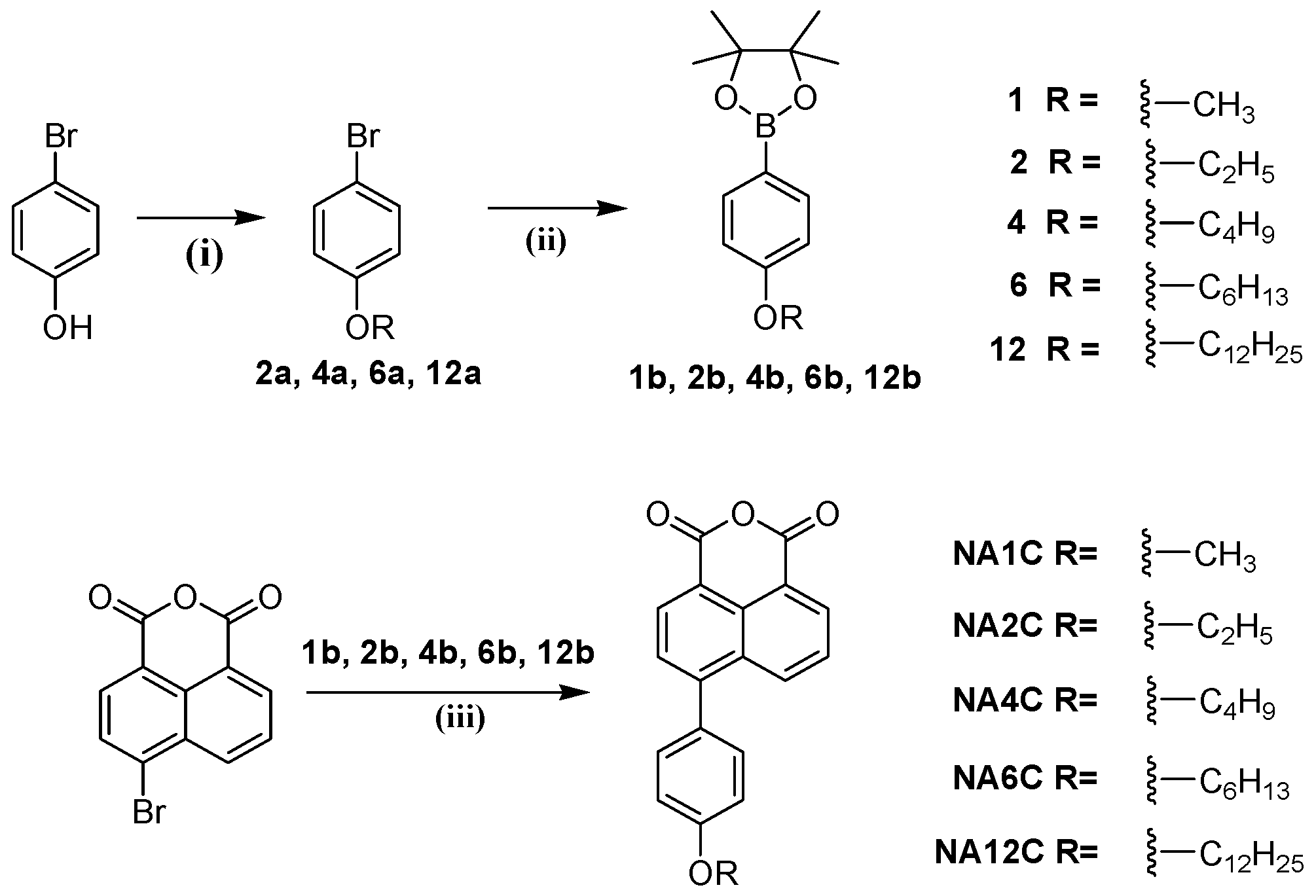
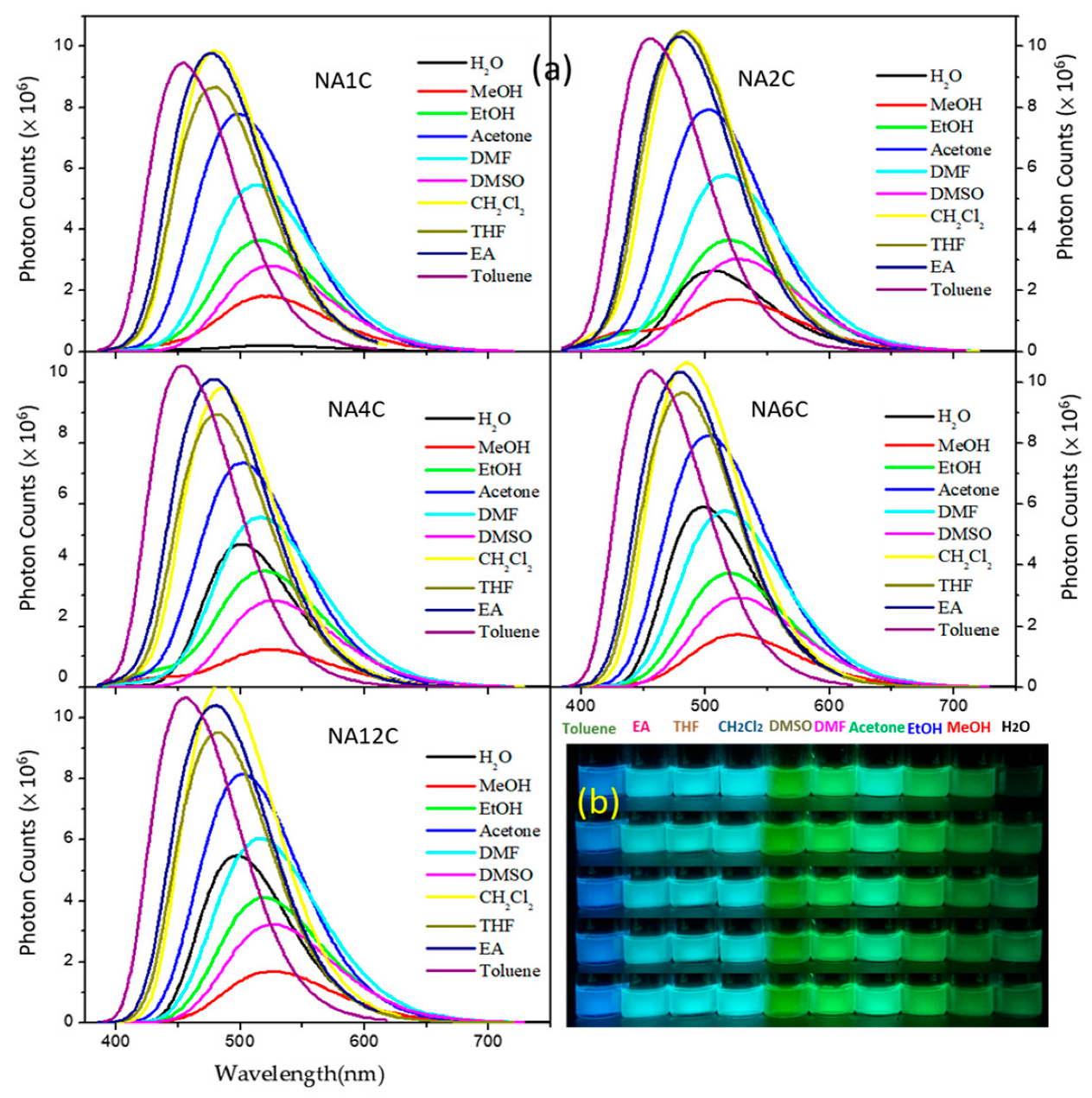
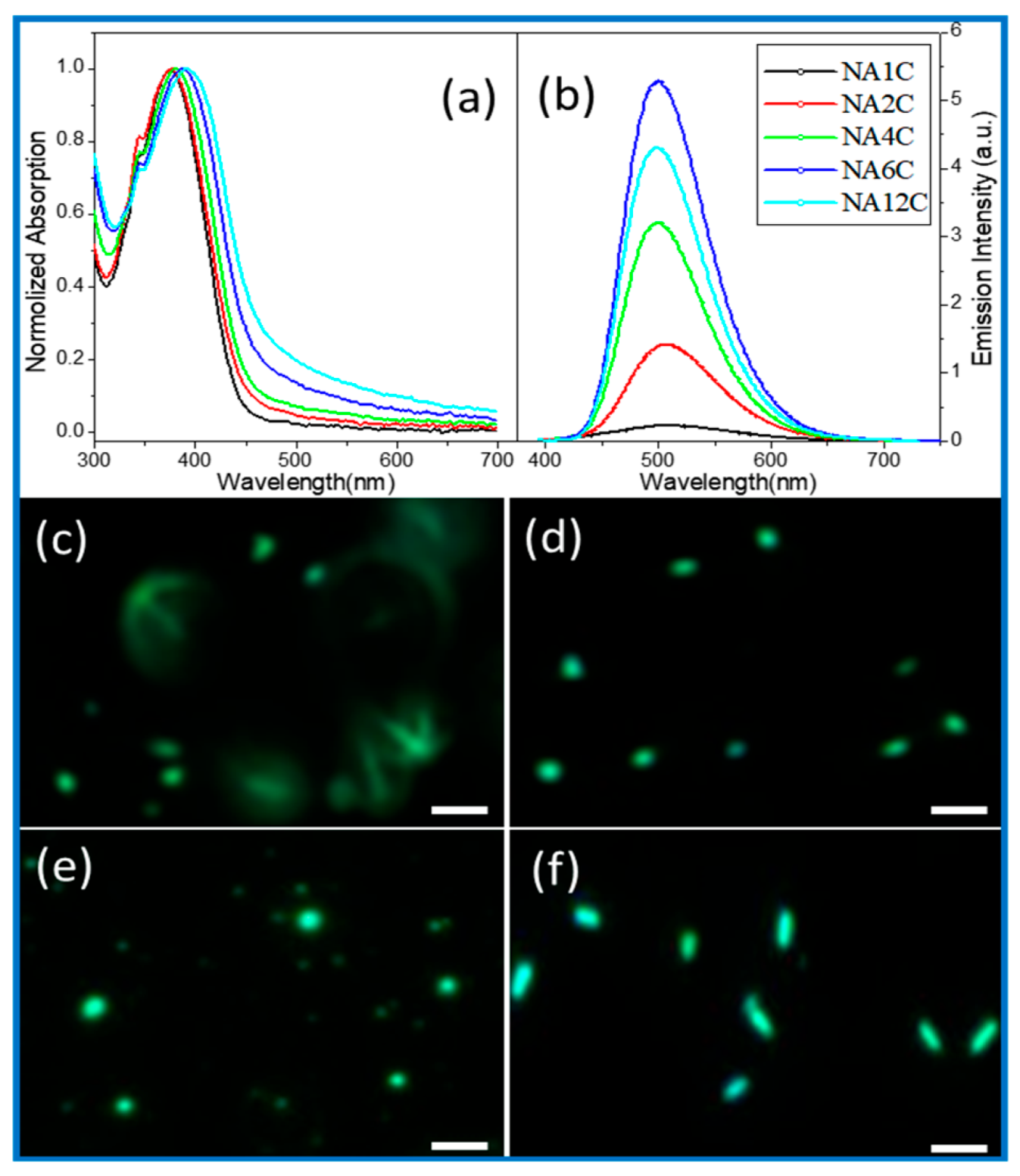

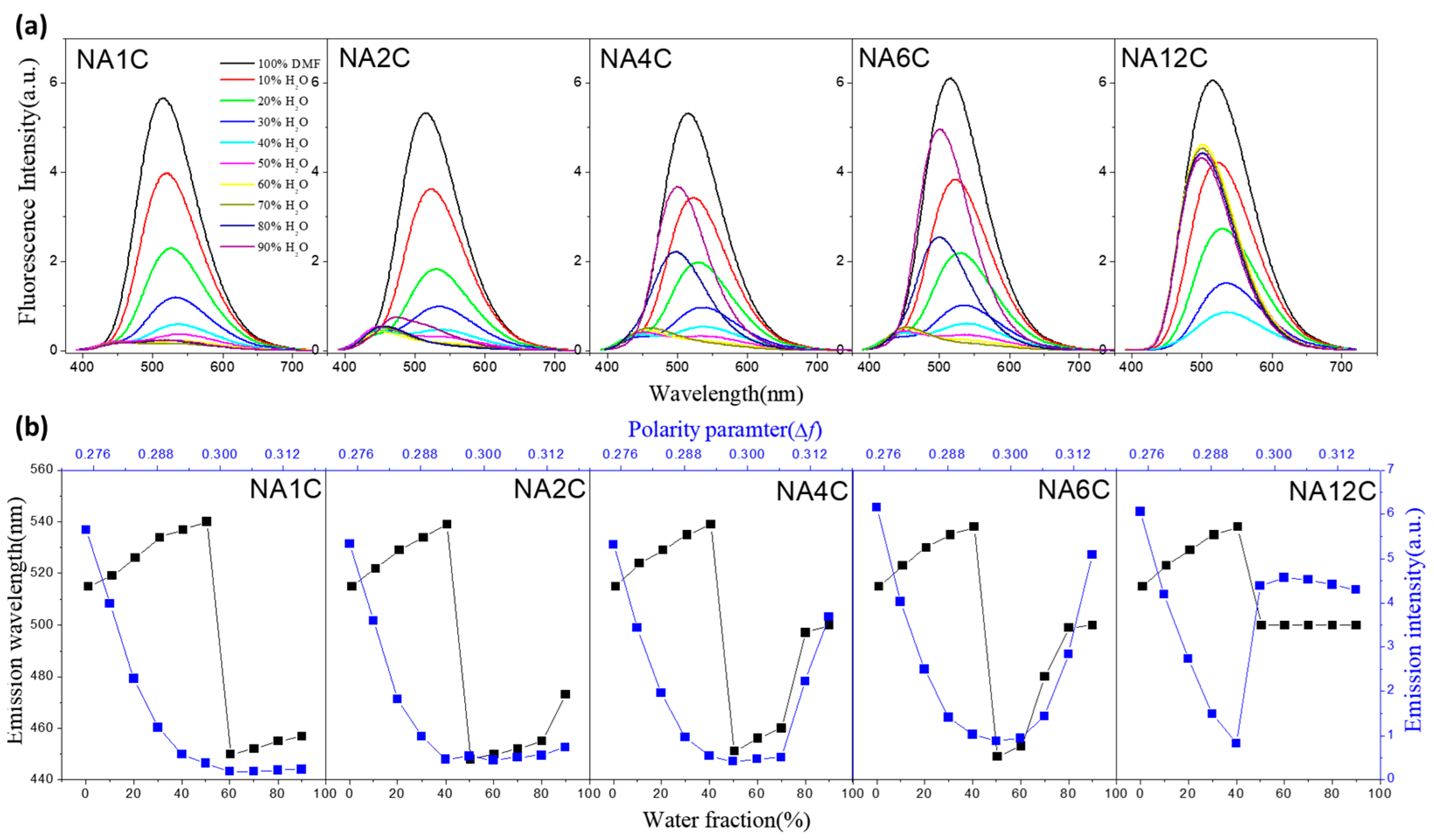
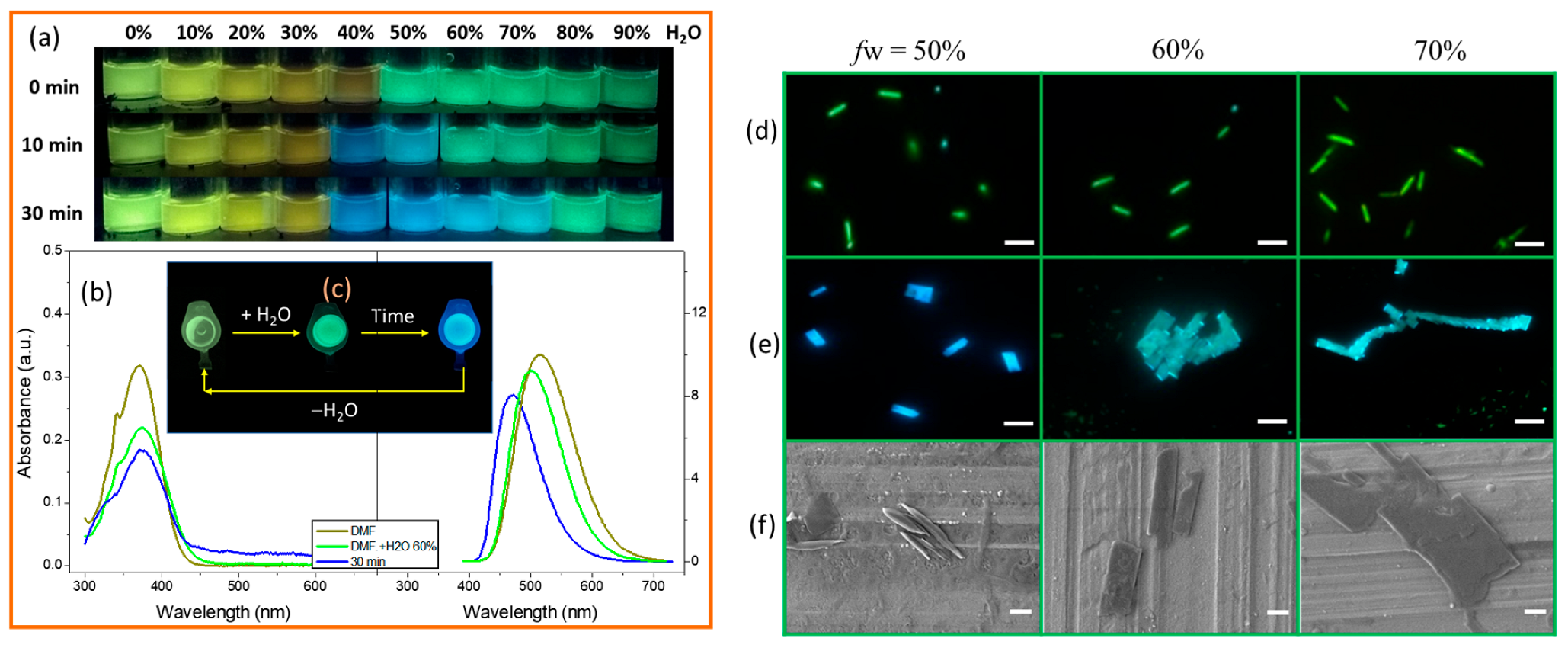
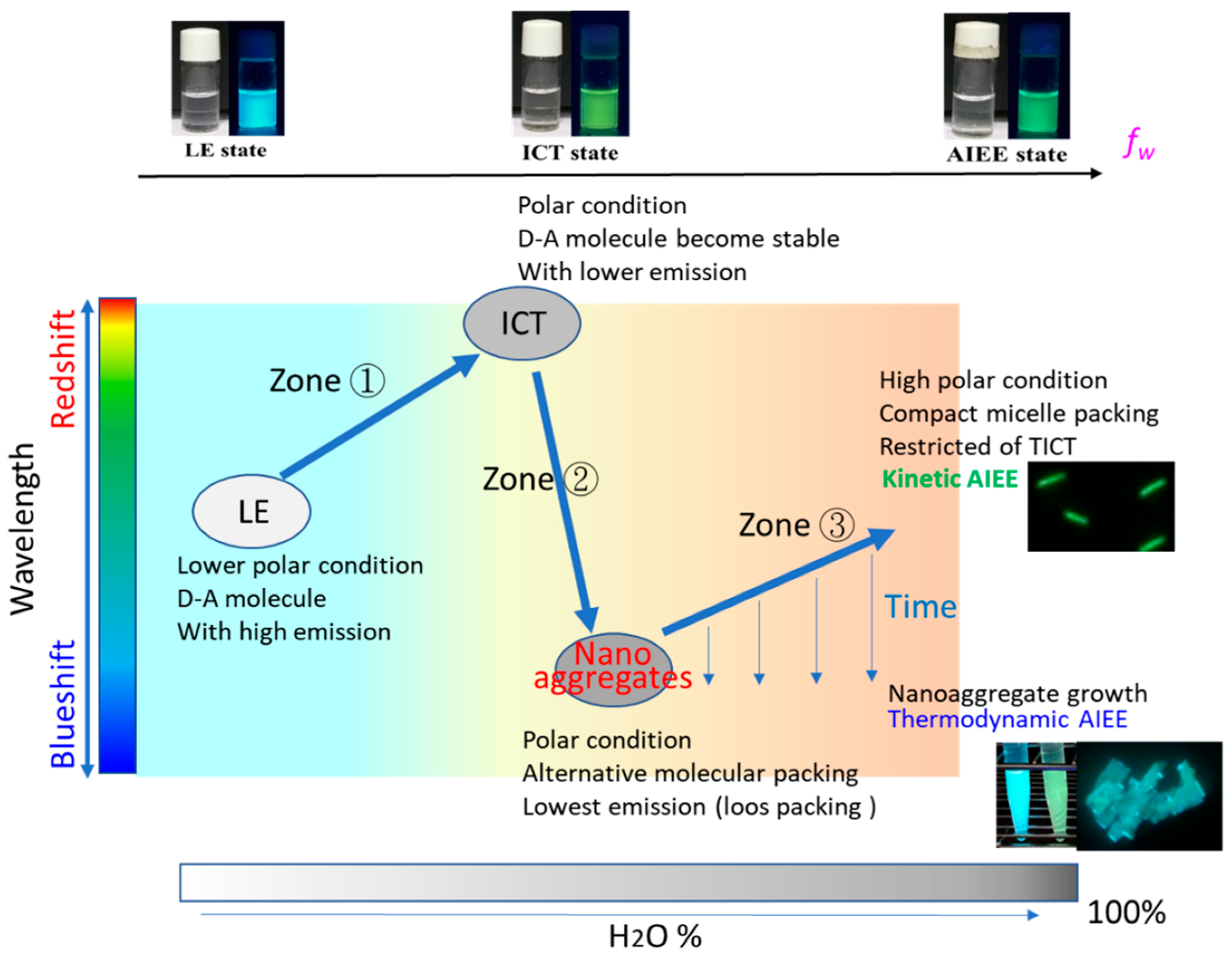
| Solvent (Δƒ) | NA1C | NA2C | NA4C | NA6C | NA12C | ||||||||||
|---|---|---|---|---|---|---|---|---|---|---|---|---|---|---|---|
| λabs | λem | Δᴠ | λabs | λem | Δᴠ | λabs | λem | Δᴠ | λabs | λem | Δᴠ | λabs | λem | Δᴠ | |
| H2O (0.320) | 381 | 527 | 7126 | 381 | 505 | 5813 | 387 | 500 | 5919 | 389 | 497 | 5627 | 382 | 495 | 6057 |
| Methanol (0.309) | 365 | 522 | 8165 | 365 | 524 | 8091 | 371 | 522 | 8090 | 370 | 526 | 8370 | 371 | 525 | 8016 |
| Ethanol (0.289) | 367 | 516 | 7758 | 368 | 521 | 7832 | 368 | 518 | 7649 | 370 | 519 | 7579 | 372 | 519 | 7579 |
| DMSO (0.263) | 370 | 525 | 7979 | 371 | 526 | 7870 | 365 | 526 | 7906 | 370 | 527 | 7655 | 373 | 526 | 7655 |
| Acetone (0.284) | 362 | 498 | 7357 | 367 | 502 | 7362 | 365 | 501 | 7402 | 367 | 503 | 7333 | 371 | 503 | 7254 |
| THF (0.210) | 364 | 478 | 6639 | 365 | 481 | 6532 | 365 | 480 | 6501 | 370 | 483 | 6427 | 369 | 481 | 6427 |
| DMF (0.275) | 370 | 513 | 7681 | 364 | 515 | 7720 | 365 | 516 | 7685 | 370 | 515 | 7430 | 369 | 515 | 7430 |
| EA (0.200) | 362 | 477 | 6540 | 364 | 477 | 6671 | 364 | 478 | 6477 | 365 | 480 | 6446 | 366 | 481 | 6446 |
| CH2Cl2 (0.219) | 369 | 477 | 6121 | 370 | 481 | 6221 | 372 | 486 | 6191 | 373 | 486 | 5977 | 374 | 486 | 5907 |
| Toluene (0.013) | 365 | 453 | 5247 | 367 | 456 | 5318 | 366 | 456 | 5147 | 370 | 456 | 5170 | 366 | 455 | 5049 |
| Lippert slope | 8877.03 | 7066.19 | 7737.289 | 7399.909 | 7889.32 | ||||||||||
| Δµ | 1.09 | 1.03 | 1.15 | 1.2 | 1.669 | ||||||||||
| μg (D) | 16.68 | 16.68 | 16.68 | 16.68 | 16.68 | ||||||||||
| μe (D) | 17.77 | 17.71 | 17.83 | 17.88 | 18.3 | ||||||||||
Disclaimer/Publisher’s Note: The statements, opinions and data contained in all publications are solely those of the individual author(s) and contributor(s) and not of MDPI and/or the editor(s). MDPI and/or the editor(s) disclaim responsibility for any injury to people or property resulting from any ideas, methods, instructions or products referred to in the content. |
© 2023 by the authors. Licensee MDPI, Basel, Switzerland. This article is an open access article distributed under the terms and conditions of the Creative Commons Attribution (CC BY) license (https://creativecommons.org/licenses/by/4.0/).
Share and Cite
Elsyed, A.F.N.; Wong, G.-L.; Ameen, M.; Wu, M.-W.; Chang, C.-C. Tunable Fluorescence via Self-Assembled Switching of AIE-Active Micelle-like Nanoaggregates. Int. J. Mol. Sci. 2023, 24, 9941. https://doi.org/10.3390/ijms24129941
Elsyed AFN, Wong G-L, Ameen M, Wu M-W, Chang C-C. Tunable Fluorescence via Self-Assembled Switching of AIE-Active Micelle-like Nanoaggregates. International Journal of Molecular Sciences. 2023; 24(12):9941. https://doi.org/10.3390/ijms24129941
Chicago/Turabian StyleElsyed, Amal Farghal Noreldein, Gah-Lai Wong, Mohamed Ameen, Min-Wei Wu, and Cheng-Chung Chang. 2023. "Tunable Fluorescence via Self-Assembled Switching of AIE-Active Micelle-like Nanoaggregates" International Journal of Molecular Sciences 24, no. 12: 9941. https://doi.org/10.3390/ijms24129941
APA StyleElsyed, A. F. N., Wong, G.-L., Ameen, M., Wu, M.-W., & Chang, C.-C. (2023). Tunable Fluorescence via Self-Assembled Switching of AIE-Active Micelle-like Nanoaggregates. International Journal of Molecular Sciences, 24(12), 9941. https://doi.org/10.3390/ijms24129941






